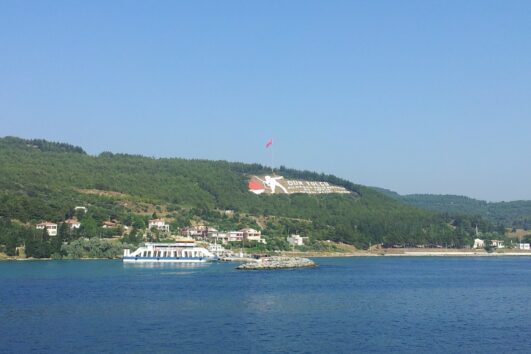
Glory of the Gallipoli Peninsula Historical National Park The Gallipoli Peninsula, a craggy outpost and historical national park, facing the Aegean Sea in Turkey's north-west, is a major tourist attraction because of its influential footnote in the history of modern-day Turkey, and the bloody campaign that saw thousands of soldiers killed and wounded in the opening months of World War 1. As the final resting place of many Turkish, New Zealand, and Australian soldiers, the war graves and museums are comparable in importance to those in France where thousands of World War 2 dead were laid. Today, it is an important landmark, for relatives and families of those that fell during that brutal nine-month campaign (April 25, 1915-January 1916). It is also a memorial to the horrors of war, and to travellers across all interest sectors, an interesting backdrop that played an influential role in Turkey's emergence as it evolved from the crumbling Ottoman Empire (now latter-day Turkey).
Build-up to the War of Gallipoli
The beginning of World War 1 in 1914 and the assassination of an archduke of Austria-Hungary by a Serbian nationalist quickly ramped up animosity between Europe's superpowers and ended up pitching neighbouring countries against each other. In a little over six weeks since the June 28 murder, Austria-Hungary had declared war on Serbia (a Russian ally); the Ottoman Empire entered a secret alliance with Germany, who in turn declared war on France and then invaded Belgium, provoking Britain and France to counter. Europe quickly fell into two alliances - Bulgaria, Germany, and Austria-Hungary against Britain, France, and Russia. World War 1 was on. The Ottoman Empire's entry into the war on the side of Germany in November 1914 came about by its potential threat to the Suez Canal, a key link for the British Empire between Europe and Asia. Britain manoeuvred its forces to strengthen its grip on the canal, while also being backed by its then British Empire allies, Australia and New Zealand, in Egypt. The Ottomans, fearful of defeat of Germany, which would mean further loss of its own empire, backed a German raid on two Russian ports. Russia responded by declaring war on the Ottomans, who then closed the important Dardanelles Straits between the Black Sea and the Mediterranean - effectively cutting off Russia's links with its allies. Following a failed naval encounter by Britain and France to seize the Dardanelles and open up the straits; to offer a strategic supply line to Russia; the Allies shifted emphasis to a land attack through the Gallipoli Peninsula, which would be a chance to seize Istanbul and neutralize the Ottoman Empire.
The Gallipoli Campaign
On the Gallipoli Peninsula, a 75,000-strong Mediterranean Expeditionary Force - with nearly half from Australia and New Zealand - began their attack on April 25, 1915. The British contingent was to take six beaches around Cape Helles in the south and the Australian and New Zealand Army Corps (ANZACs) were to take three in the north at Gaba Tepe (Kabatepe). The apparent premise by the British military that the Ottomans would be weak and prove no match to their superior skills proved their undoing. If anything, bad planning of the geographical landscape was the major cause of defeat for the Allies. The Anzacs landed further away from their intended target, later to become known as Anzac Cove. They were forced to climb cliffs off the beach and straight into the waiting Turks' fire. Equally, the British took three beaches, but at another, Sedd-el-Bahr, many were cut down at sea by the dug-in Turkish gunners. 
For the Ottomans, a little known Mustafa Kemal became the frontline commander of the 19th Division of the Fifth Army after anticipating where the Allies would land. His tactical planning and strong leadership largely kept the Allies at bay. Trench warfare ensued and by August, the Allies launched a second key assault. Nevertheless, despite the ANZACs taking one hill and incursions into Suvla Bay, the general operation was rebuffed with counter attacks. Both sides took heavy casualties and the decreasing health situation, including the lack of sanitation, disease, an explosion in flies and the number of bodies that littered the battlefields, took its toll. British public sentiment turned at home, and in January 1915, a massive evacuation was underway, with the last soldiers leaving Ottoman soil on January 8. During the nine-month campaign, the British suffered 21,255 deaths, and 52,230 wounded; Australia suffered 8,709 deaths, 19, 441 injuries; New Zealand incurred 2,770 deaths, 5,212 wounded, while the Ottoman Empire accounted for 86,692 deaths, and 164,617 wounded.
Visiting Gallipoli Today
The aftermath of that campaign led to the resignation of Winston Churchill, the eventual downfall of several empires and the rise of Mustafa Kemal as the architect of latter-day Turkey.

At Gallipoli today, tourists and families of the war dead, remember both the Ottomans and the Allied soldiers. At Anzac Cove, there is a memorial, but it is the many cemeteries that dominate the area. Lone Pine Cemetery alone has over 7,000 graves of Australians while important sorts such as Chunuk Bair and Lone Pine Cemetery. To the south, the village of Alcitepe hosts the Salim Mutlu War Museum, the Gallery of the Gallipoli Campaign, while there are scattered cemeteries of British, French, and Turkish soldiers. The Morto Bay-based Abide Monument (Canakkale Sehitleri Aniti) remembers all Turkish soldiers that fell during that bloody campaign. All the battlefields and cemeteries all fall within the 33,000-hectare Gallipoli Peninsula Historical National Park.
Memorial Days at Gallipoli
The Gallipoli Campaign is now remembered on both sides. On April 25, known as Anzac Day, Australians and New Zealanders travel thousands of miles to arrive in Turkey for the day to remember relatives who died. In Turkey, the date of March 15 marks Gallipoli Victory Day. Note: Our two-day from Istanbul takes you to visit the memorial grounds of Anzac Cove as well as the UNESCO World Heritage site of Troy. Find out more details here.






